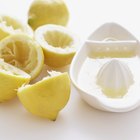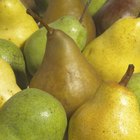
Some fruits retain their color and fresh appearance almost indefinitely after they're cut, making them ideal for fruit salads, party trays and kids' lunches. Unfortunately that's not true of a few big favorites, such as apples and bananas. If you want to prepare apples ahead of time you'll need to dip them in an anti-browning solution. There's a myth that baking soda will work, but in truth you need an acidic ingredient.
Fruits and Browning
Fruits such as bananas, apples and pears brown when they're peeled and cut because of a chemical reaction that takes place in their cells. There are three ingredients in that reaction. One is a set of phenols, or flavoring compounds. The second is naturally-occurring enzymes in the fruit, and the third is oxygen. Normally the enzymes and phenolic compounds are kept apart by the cell walls, but when you slice or peel the fruit you break those cell walls and let them mix. You also bring them into contact with oxygen from the outside air. To slow the browning, you need to stop or slow that chemical reaction.
Slowing the Browning
You can slow the browning process either by attacking the enzymes, or by keeping oxygen away from the cut fruit. Dropping the fruit in water or another liquid helps, by minimizing the amount of available oxygen. Refrigerating the fruit slows the action of the browning enzymes, so that can also buy you some time. Acidity also slows and disables the browning enzymes. The most effective way to stop browning combines all three of those techniques: stir an acidic ingredient into the water, submerge the apple pieces, and refrigerate them when possible.
Acidic Ingredients
To minimize browning you can use any acidic ingredient you happen to have in the kitchen. The most common choice is lemon juice, which effectively counters the browning without adding a distinct flavor. Commercial anti-browning powders use either citric acid or ascorbic acid, which have the same virtues. Ascorbic acid is better known as vitamin C, and you can achieve the same effect by grinding up a tablet and dissolving it in your water. Dedicated bakers often have cream of tartar in their cupboard, another effective acidifier. An often-overlooked choice is apple juice, which provides the necessary acidity and doesn't leave the apples tasting watery after extended storage.
Baking Soda
Baking soda doesn't work for fruit because it's the opposite of an acidic ingredient. It's a base or alkaline substance, which foams when it comes into contact with acidity. If you dip or soak your apples in baking soda water it'll make the cut surfaces soften and become unappealingly mushy. Soda can help preserve the fresh color of green vegetables if it's added to the cooking water, which might be why some cooks assume it'll preserve the color of fruit as well. Unfortunately, while it keeps the greens bright and attractive, it also gives them a mushy texture and reduces their nutritive value.
Related Articles
How to Keep Peach Preserves From ...

What Happens to Bananas Dipped in Lemon ...
Why Does Lemon Juice Keep Potatoes From ...
How to Keep Granny Smith Apples From ...

Why Does Lemon Juice Stop Apples From ...
How Long Is it Safe to Keep Frozen ...

Does a Kiwi Turn Brown?
Does Baking Soda Prevent Apples from ...

How to Preserve Fresh Apples

How Do I Prepare Pears for Freezing?

How to Keep Peeled Vegetables From ...

Why Pears Turn Brown When Pureed
How to Keep Cut Cabbage From Going Brown
How to Wash Fresh Fruit With Peroxide

How to Freeze Apples With Lemon Juice
Easy Homemade Apple Pie Filling Recipe

How to Freeze Raspberries

How to Freeze a Prickly Pear Cactus

Best Fruit Juices to Cleanse the Colon
Easy Peach Cobbler Recipe
References
- On Food and Cooking: The Science and Lore of the Kitchen; Harold McGee
- Alabama Cooperative Extension System: Anti-browning Solutions Preserve Natural Color of Fruits
- Scientific American: Why Do Apple Slices Turn Brown After Being Cut?
Writer Bio
Fred Decker is a trained chef and certified food-safety trainer. Decker wrote for the Saint John, New Brunswick Telegraph-Journal, and has been published in Canada's Hospitality and Foodservice magazine. He's held positions selling computers, insurance and mutual funds, and was educated at Memorial University of Newfoundland and the Northern Alberta Institute of Technology.
Photo Credits
Creatas Images/Creatas/Getty Images